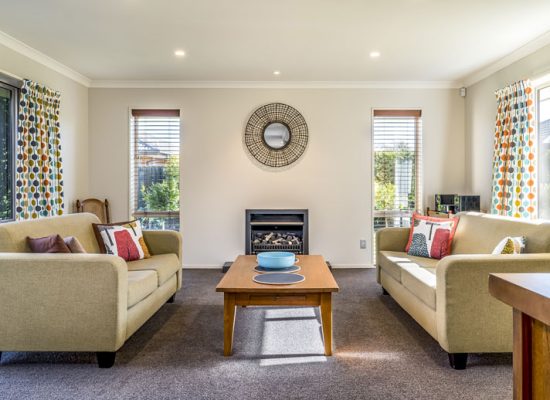A living room is not just a place to sit—it is the heart of the home, where families gather, guests are welcomed, and memories are created. But what if your living room feels too small or congested? Don’t worry! With the right design strategies, even the smallest room can be transformed to look more spacious, brighter, and welcoming.
In this article, we’ll walk you through step-by-step design techniques that professional interior designers use to visually expand a small living room. From choosing the perfect wall colors to arranging furniture smartly, you’ll discover practical solutions you can apply to your own home.
1. Choosing the Right Wall Colors

When it comes to making a small room look larger, wall paint color plays a critical role. Many people don’t realize that the wrong shade can make a room feel even more cramped. So how do you choose the perfect color?
Color Families to Consider
When it comes to making a small room look larger, wall paint color plays a critical role. Many people don’t realize that the wrong shade can make a room feel even more cramped. So how do you choose the perfect color?
Wall colors generally fall into three families:
- Pastel Colors – Soft and light shades that make spaces look airy.
- Bold Colors – Deep, strong shades that absorb light and make rooms feel smaller.
- Neutral Colors – Shades like beige, gray, or off-white that add elegance and a sense of openness.
For a small living room, avoid bold colors. Instead, go with pastel or neutral tones. Among these, neutrals are the best choice because they create a timeless, sophisticated look while making the space appear larger.
Why Neutrals Work
This isn’t just a design opinion—it’s backed by science. A classic German study on “Irradiation Reflection” (1860) showed that when two identical objects are painted in light vs. dark shades, the lighter one always appears larger to the human eye.
So, applying this logic to your living room:
- Light neutrals like beige, ivory, or soft gray will visually enlarge the room.
- Dark tones, even if stylish, will make the walls close in and the space feel tighter.
Pro Tip: Stick to One Color
Another key rule is to use only one paint color per room. Many homeowners make the mistake of painting one wall differently to create an “accent wall.” But this actually divides the room visually and makes it appear smaller.
In fact, a study published in the Journal of Environmental Psychology (2021) proved that objects with a single uniform color look larger compared to the same-sized objects painted in multiple colors.
So the safest and smartest option is:
- Choose one neutral paint color
- Apply it to all four walls
- Use textures, lighting, or décor for interest instead of multiple paint shades.
2. Design Patterns & the Master Wall
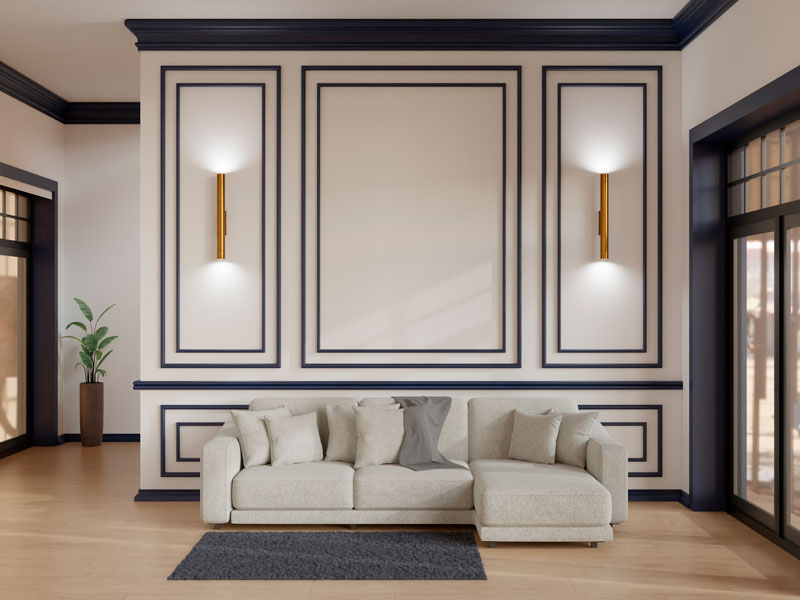
After selecting the right color, the next step is deciding how to treat your master wall—the focal wall of your living room. Many homeowners think they need a bold contrasting paint color to highlight it, but that’s actually a mistake.
Stick to a Monochromatic Theme
The golden rule here is to follow a monochromatic theme. This means that all walls, including your master wall, should remain within the same color family. A slight variation in tone is acceptable (for example, a slightly darker or lighter shade of beige or gray), but never use a completely different color.
👉 Why? Because introducing a new color creates unnecessary partitions, which visually shrink the room.
How to Create Interest Without Color Contrast
If you want your master wall to stand out, you don’t have to rely on bold paint. Instead, create interest through textures and patterns:
- Wall Trims or Moldings – Add dimension while keeping the wall color consistent.
- Photo Frames or Artwork – Personalize your space without breaking the color harmony.
- Wooden or PVC Paneling – Adds warmth and elegance while staying in the same shade range.
- POP (Plaster of Paris) Designs – Subtle designs that give character without overpowering the room.
Vertical Over Horizontal
One important design tip: Always prefer vertical patterns over horizontal ones.
- Vertical lines or panels draw the eye upward, making the ceiling appear higher and the room more spacious.
- Horizontal designs cut the wall into segments, which can make the space look wider but also more compressed and cluttered.
✅ So the rule is simple:
- Keep the color within the same family,
- Use texture or material instead of contrasting paint,
- Go vertical to add height and elegance.
This way, your master wall becomes the highlight of the living room—without sacrificing spaciousness.
3. Space Planning: The Rule of 75/25
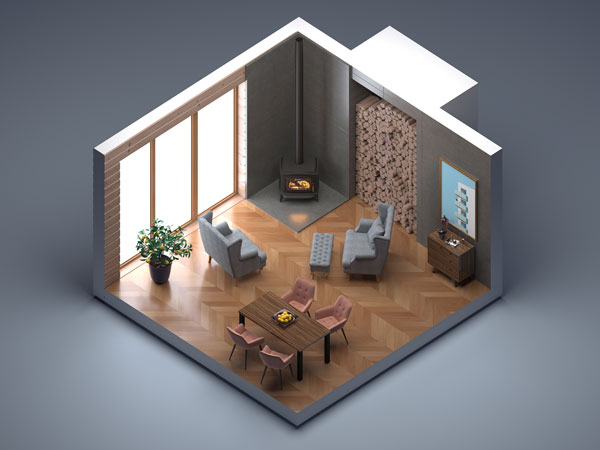
A small living room doesn’t just need to look bigger—it also needs to feel functional. Since this space is used the most (family gatherings, guest seating, TV watching, etc.), proper movement flow is critical. That’s where the Rule of 75/25 comes in.
What is the Rule of 75/25?
The formula is simple:
- 25% of the floor area can be covered with furniture.
- 75% must remain visible and open for free movement.
This ensures that the room feels spacious instead of cluttered.
Example Calculation
Let’s say your living room measures 12 ft × 12 ft = 144 sq. ft.
According to the rule:
- 25% = 36 sq. ft. → This is the maximum area your furniture should cover.
- 75% = 108 sq. ft. → This should remain open and visible.
Now here’s the challenge:
Most people exceed this limit without realizing it.
- A five-seater sofa alone takes ~20 sq. ft.
- Add a center table (~5 sq. ft.),
- A TV unit (~10 sq. ft.),
- Plus lamps and side tables (~5–6 sq. ft.).
👉 Very quickly, you end up covering 41 sq. ft., which breaks the rule and makes the room feel cramped.
Tricks to Stay Within the Rule
Since fully restricting furniture to 25% is difficult, here are some design tricks to visually maintain openness:
- Choose lightweight furniture
- Sofas and chairs with visible legs create a sense of airiness.
- Avoid bulky pieces that block the floor entirely.
- Opt for transparent or slim tables
- A glass-top center table or one with slim legs allows the floor to remain visible.
- Wall-mounted units
- Instead of a heavy TV cabinet on the floor, go for a floating wall-mounted unit to free up space.
- Compact ottomans & stools
- Choose smaller seating options that don’t cover the entire floor.
- Wall-hung lamps instead of floor lamps
- Keeps the floor clean and clutter-free.
By applying these tricks, your living room will follow the 75/25 principle visually—even if the furniture technically covers a bit more area.
4. TV Size & Unit Design
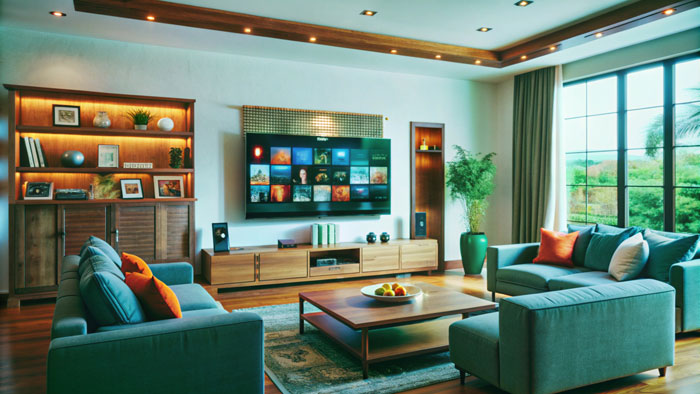
Choosing the Right TV Size: The Formula of 2.2
A TV is almost a permanent fixture in the living room. But one of the most common mistakes people make is buying a disproportionately large television. Not only does it dominate the space, but it also makes a small living room feel even smaller.
So, how do you determine the perfect size?
👉 Use the Formula of 2.2:
- Measure the distance between your TV wall and your seating area (in inches).
- Divide this number by 2.2.
- The result is the ideal TV size (in inches).
Example:
- Distance = 10 feet = 120 inches
- 120 ÷ 2.2 = 54 inches
That means a 54-inch TV is perfect for a 10-foot viewing distance. Since 54″ may not always be available, simply choose the nearest available size (e.g., 55″).
Following this formula ensures your TV looks proportionate, provides a comfortable viewing experience, and avoids unnecessary eye strain.
Designing the Perfect TV Unit for a Small Living Room
The TV unit is as important as the TV itself. For small spaces, these guidelines are essential:
1. Avoid Floor-Mounted Units
Never choose a TV cabinet that sits directly on the floor.
It eats up valuable floor area and makes the room feel smaller.
Instead, opt for a floating TV unit. But remember, “floating” doesn’t mean just 2–3 inches above the floor. To truly maximize openness, the unit should be installed at least 8 inches above the floor. This keeps the floor visually clear and makes the room appear larger.
2. Slim Drawer Design
The drawers of your TV unit should be sleek and minimal—no more than 6 inches in height.
Larger drawers make the unit look bulky and heavy, which is the opposite of what a small room needs.
3. Side Shelves
If possible, avoid side shelves altogether. If you do add them:
- Keep them open, or
- Use glass shutters.
Never use fully closed shutters, as they add visual heaviness.
Pro Tip: Always integrate lighting inside the shelves. It doesn’t affect the perceived size of the room, but it adds beauty and elegance to the overall design.
4. Back Panel Design
The back panel offers unlimited design possibilities. The key rule: match it with your room’s overall theme.
- For a gray-themed room, use white-and-gray laminates.
- For a beige-toned room, use brown-beige laminates or textures.
Always choose vertical designs over horizontal ones. Vertical patterns emphasize height and help make the room appear taller and more balanced.
Following these principles ensures that your TV and unit look proportional, elegant, and spacious—instead of overwhelming the room.
5. Sofa Selection: Shape, Color, Height & Fabric
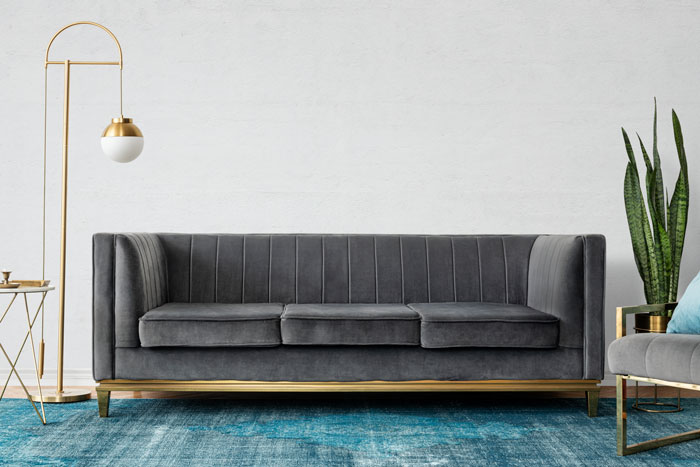
The sofa is the largest piece of furniture in your living room—its presence defines the entire space. That’s why making the right choice is crucial. Here are the key factors to consider:
Aspect | Recommendation |
Shape | Avoid bulky L-shaped sofas as they look heavy and blocky. Instead, choose one three-seater sofa + two chairs. This still seats five people but keeps the room lighter and more open. |
Color | For small living rooms, always go with single-tone colors. |
Height | Sofas with very high backrests feel bulky and overwhelming. Instead, opt for low-height sofas. These look modern, trendy, and spacious while still being comfortable. |
Fabric | Common options: Leatherette, Velvet, Suede, Cotton. |
6. Windows & Balcony Doors
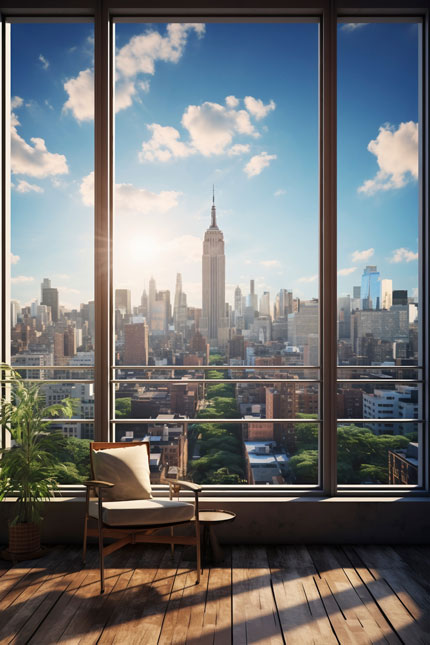
Your living room windows—or the doors that open to your balcony—play a massive role in how spacious your room feels. The bigger the window, the better. Ideally, go for floor-to-ceiling, wall-to-wall windows that stretch from the top beam to the floor, covering as much wall as possible.
Why Bigger Windows Matter
- A solid wall makes the room feel bulky.
- Replacing that wall space with glass makes the room feel lighter and more open.
- Large windows allow in abundant natural light, instantly making even a small living room feel airy, spacious, and welcoming.
This is why bungalows, farmhouses, and hotel rooms often feature massive windows—it creates a luxurious and expansive feel. The same principle applies perfectly to small living rooms.
Key Things to Remember
1. Choose the Right Material
If you’re installing floor-to-ceiling windows, avoid wooden frames.
- Wooden frames are thick and heavy, which makes the space look bulky.
- Instead, go for UPVC or aluminum frames.
✅ Best Choice: Aluminum
- Sleek and stylish finish
- Thin borders for a modern look
- Highly durable
💰 Cost comparison (in Bangladesh):
- UPVC: ৳900–1000 per sq. ft.
- Aluminum (good brand): ৳1400–1600 per sq. ft.
While aluminum is slightly more expensive, it looks far more premium and stylish.
2. Avoid Traditional Grills
Many people install grills on wooden windows, but these look outdated and cluttered. Instead, use security glass:
- Stronger than regular glass
- Fully transparent, enhancing spaciousness
- Modern and stylish look
In fact, high-quality UPVC or aluminum windows already come with secure locking systems, eliminating the need for grills altogether.
To make your living room appear bigger and more modern:
- Install large aluminum windows
- Use security glass
- Completely avoid bulky grills
7. Curtains & Drapes: How to Choose the Perfect One for Small Living Rooms
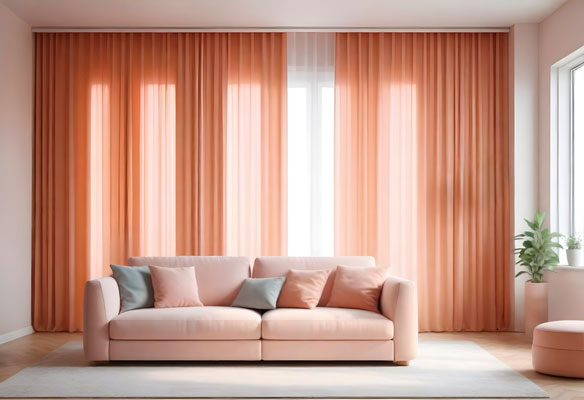
When designing a small living room, curtains may seem like a minor detail—but in reality, they can dramatically impact how spacious and stylish your room feels. Choosing the right type of curtains not only enhances beauty but also ensures the room looks open, balanced, and elegant.
Always Go for Full-Size Curtains
The number one rule for curtains in small spaces is simple:
👉 Always use full-length curtains.
This means your curtain should start almost from the ceiling and extend all the way down to the floor. Leave just 1 inch of space at the top and 1 inch at the bottom for a neat finish.
Common Mistake to Avoid
Many people install the curtain rod just above the window—2–3 feet below the ceiling—and hang the curtains there.
⚠️ This creates a visual break in the wall, making the room appear smaller and more cluttered.
Instead, let your curtains run from top to bottom—it makes your walls look taller and your room much larger.
What About Small Windows?
If your window is small, skip the curtains entirely.
👉 Use blinds instead.
Blinds are sleek, minimal, and save visual space—making them the best option for smaller windows.
Curtain Design: Keep It Simple
✅ Always choose single-tone, solid-colored curtains.
Avoid:
- Heavy floral prints
- Stripes or patterns
- Overly decorative or bulky designs
Instead, opt for slightly thicker fabrics that block light effectively. Heavy designs make the room feel bulky, but simple designs keep it airy and light.
Choosing the Right Curtain Color
🎨 The curtain color should always harmonize with your room’s theme.
- For a beige-themed room, use beige-toned curtains.
- For a grey-themed room, go with grey or similar shades.
You may add subtle variations like light blue or stone-grey, but avoid completely different or contrasting colors.
👉 The golden rule: Your curtain color must blend seamlessly with the overall room palette.
Curtains are not just a finishing touch—they play a key role in how large and elegant your living room feels. By following the full-size curtain rule, keeping the design simple, and matching the color with your room theme, you can transform even the smallest spaces into stylish, spacious interiors.
8. False Ceiling Design for Small Living Rooms
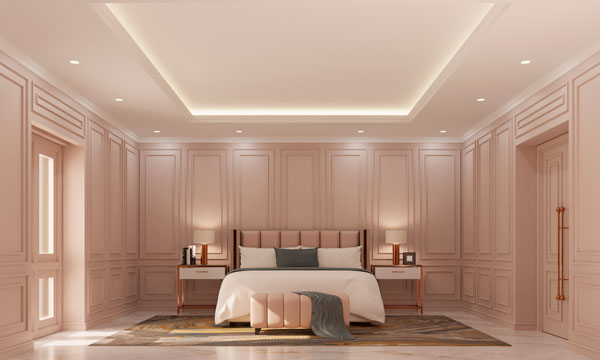
A false ceiling is often the finishing touch that ties an interior together. But in small living rooms, the wrong ceiling design can make the space look cramped. Here’s how to design a modern false ceiling in Bangladesh that makes your room look bigger, brighter, and more stylish.
❌ What to Avoid in False Ceiling Design
👉 Avoid multi-level false ceilings.
In small rooms—even with a 10 ft ceiling—multi-level designs reduce the height, making the space feel much smaller.
👉 Avoid too many coves, patterns, or heavy designs.
- They make the room look bulky and messy.
- Overly complicated designs are outdated.
✅ Instead, always go for a single-level false ceiling with a simple design. Even a flat ceiling can look elegant when styled correctly.
✅ Best False Ceiling for 9 ft Height Rooms
If your ceiling height is 9 feet or more, a plain false ceiling (single-level) is the best choice.
From there, let the lighting design do the magic. Options include:
- Profile lights
- Track lights
- Linear strip lights
- LED panel lights
These modern lighting options not only brighten up the room but also make the ceiling look stylish without adding bulk.
⭐ Want Some Design Variation? Go for a Reverse Cove
If a plain ceiling feels too simple, you can try a reverse cove design.
- The center of the ceiling stays flat.
- A soft cove is added around the edges near the walls.
- Lights placed in the cove shine towards the walls, creating a soft and elegant glow.
⚠️ Pro Tip: Use this design only if your ceiling height is at least 9 ft.
🚫 For Rooms Below 9 ft Height
If your room’s ceiling is less than 9 ft:
👉 Don’t place the false ceiling in the center.
Instead, add a border false ceiling around the edges only, and install lights there.
💡 Tip: Keep the border edges slightly curved (not sharp 90° angles). This small detail makes the room look more modern and visually appealing.
🎯 Why False Ceiling Matters
A well-designed false ceiling for small living rooms in Bangladesh makes the space feel taller, brighter, and more welcoming. By keeping the design simple and focusing on lighting, your ceiling becomes a highlight instead of a burden.
Final Words
By following these rules, your small living room will look larger and more stylish. With the right false ceiling design, you’ll never feel like your space is too small.
👉 If you’re planning your home or office interior design in Bangladesh, Dera Interior is here to help.
🌐 Visit: derainterior.com
📱 Call: 01303-907056
At Dera Interior, we don’t just decorate—we make your home comfortable, beautiful, and stylish.

